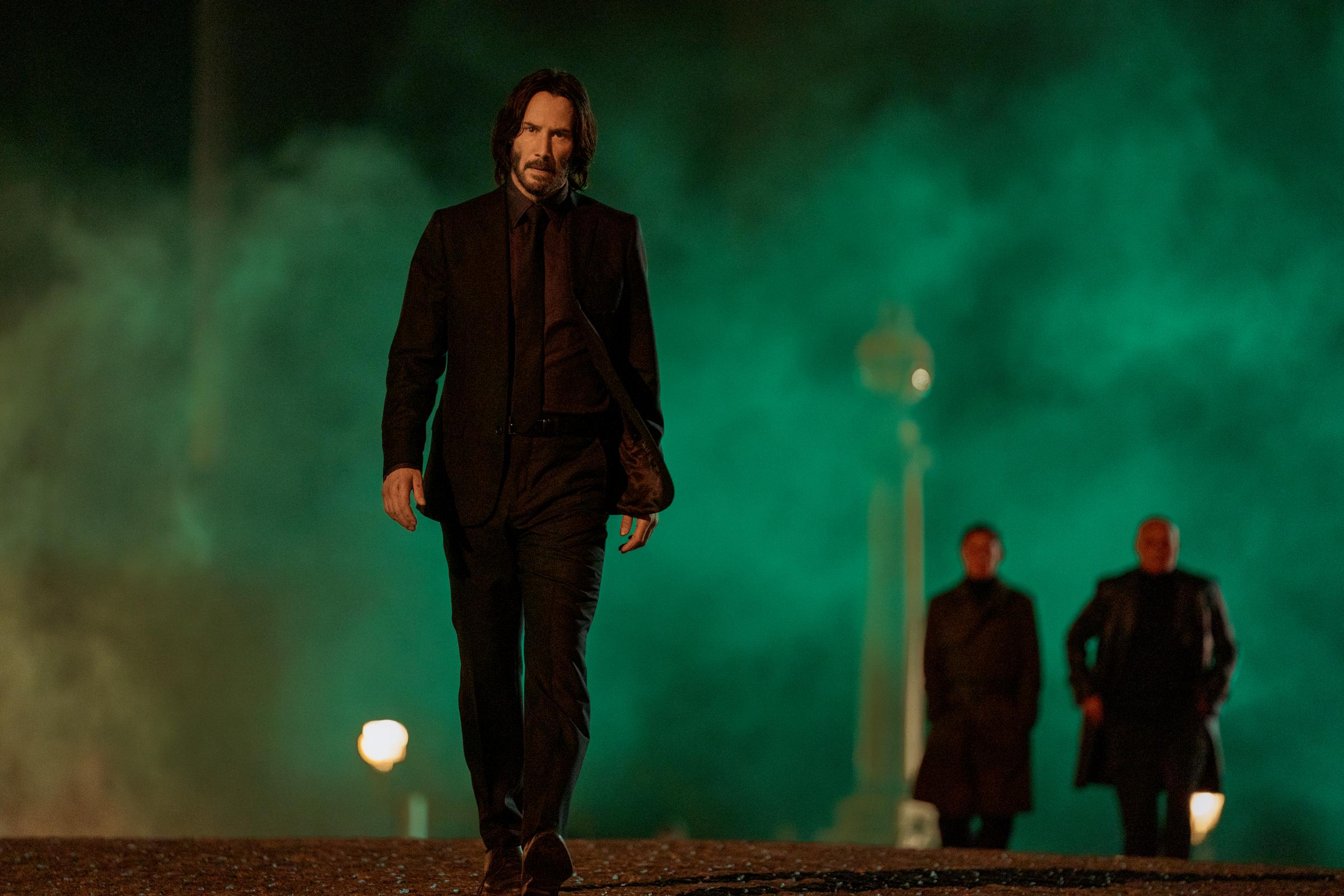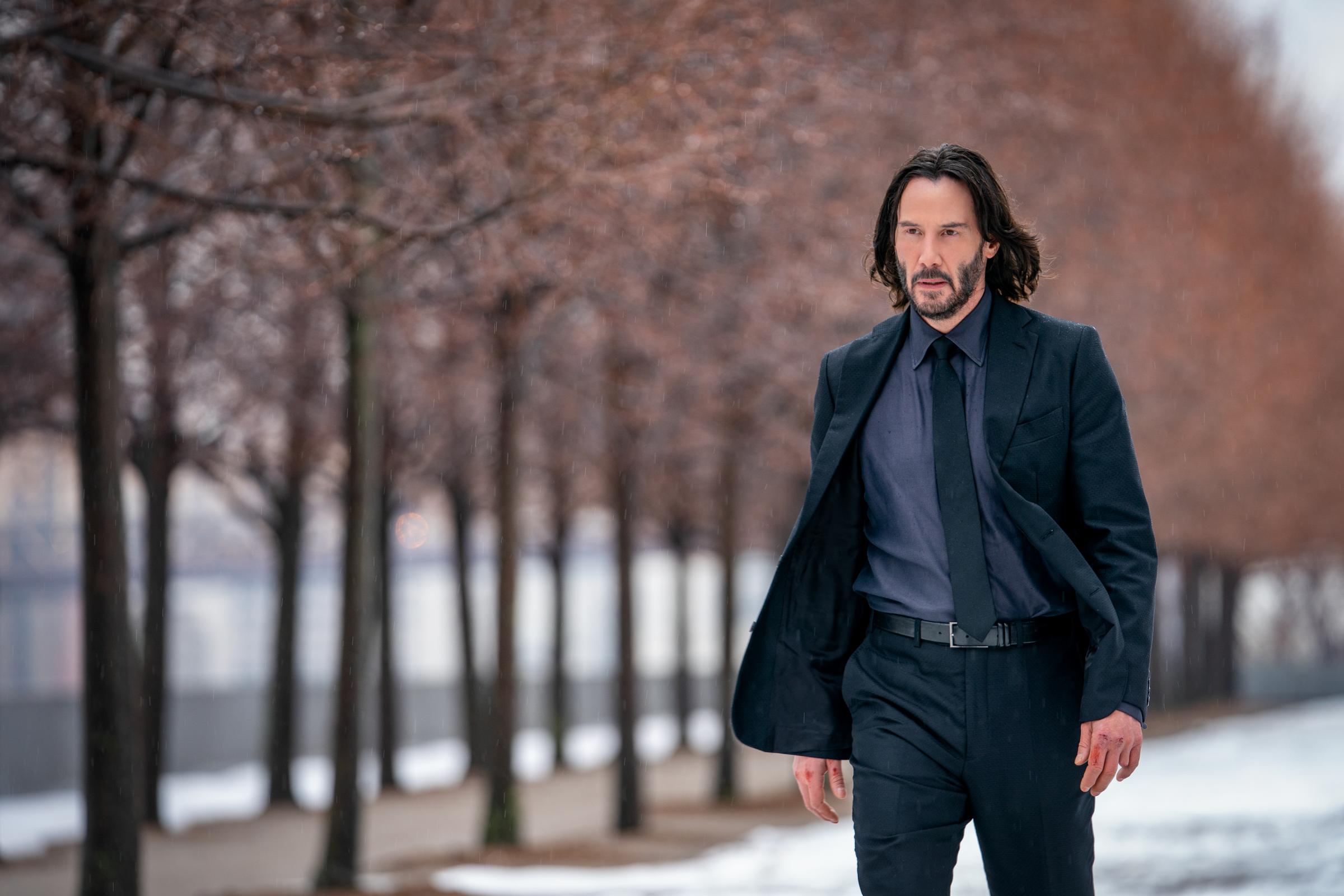
The allure of a franchise is that it offers more of something you love, ostensibly buffed up and freshened—it’s newness with sameness built in. The James Bond movies, the Thin Man comedies of the 1930s and 1940s, a long, undulating string of Rocky pictures stretching from 1976 to pretty much yesterday: franchises are nothing new, because the instant Hollywood sees one dollar sign, it starts sniffing the trail for the next. Audiences respond as they’re conditioned to, wanting more of something they loved last year, or the year before, or even in the previous decade. In the case of the Marvel Cinematic Universe, the cycle is apparently endless, perhaps stretching beyond even our children’s lifetimes. No one who’s making money off a current franchise wants to ask the multi-million-dollar question: what if the most elegant and dignified thing a franchise can do is…end?
Specifically, is it time to say good-bye to John Wick?
The answer presented by John Wick: Chapter 4—nearly three hours of gorgeously staged practical action sequences, and a heavy dose of Keanu Reeves as the dolorous existential hit man of the title—is a resounding maybe, not because the film isn’t satisfying, but because it is. And as a person who adored the first film—and who has enjoyed every sequel so far, on a scale ranging from greatly to moderately—I can’t shake the sense that the series is pushing its luck.

My taste for movie violence is specific and antiquated, a kind of dinosaur love. Movie violence isn’t what it used to be; it has become something of a lost art. Audiences have been conditioned to think fast, choppy cutting is exciting by itself, which means action sequences are often sliced-and-diced into an illogical coleslaw. You can’t tell who’s coming from where; you barely get a chance to savor the sight of bodies in motion, clashing, stumbling, clutching at one another in a wild, feral embrace. Forget the bloody, balletic exhilaration of movies like Bonnie and Clyde and The Wild Bunch, or John Woo’s 1990s Hong Kong action extravaganzas: movie-action craftsmanship took a turn for the worse in the early 2000s, and with the ascent of the Marvel universe—movies in which the ostensibly exciting action sequences are literally nearly all the same, and heavily doctored with CGI—the discipline and clarity of thought necessary to make a good fight scene seemed all but lost.
Read more: Why It Took Keanu Reeves 30 Years to Become an Overnight Sensation
But the 2014 John Wick—directed by Chad Stahelski and David Leitch, guys who’d actually worked as stuntmen—was different. The action sequences had been choreographed into episodes of thrilling, brutal beauty, blocked with care and edited with painterly precision. Weighing in at a trim, tough 96 minutes, it was as bold as a fist, plucky and defiant, with a smoldering movie star at its heart. No wonder audiences fell in love with it and, specifically, with Reeves-as-Wick. Though he’d already had a long career of almost unequivocal likability, John Wick pushed him into a new realm. You could almost diagram the movie’s blunt emotional efficiency with a series of arrows and stick figures. Here was a suffering hero, a killer trying to turn over a new leaf, who’d just lost his beloved wife to cancer—and then vengeful baddies kill the small, adorable dog she’d left him as a comfort. No one could blame Wick for kicking back against those villains, but he was also kicking out at the unfairness of the world. John Wick represented a new breed of action-noir, with a hero who drew from the tough-but-tender repertoire of great noir figures like Robert Mitchum and John Garfield, men who couldn’t be duped by anything but love—it would always be their undoing. Wick, a man who’d lost love through no fault of his own, was the ultimate fatalistic romantic hero, a man so broken he had nothing left to lose. His killing-machine amorality was both tragic and cathartic.

And as of John Wick: Chapter 4—directed by Stahelski—it still is, though the appeal of the franchise is in danger of wearing thin. Each successive entry has become longer and more elaborate, and each strays a little further from the original’s plainspoken, ragged grandeur, like a photograph that’s been Xeroxed too many times. The action scenes are as elegantly blocked and as cleanly shot as ever, but they also bear the weighty responsibility of trying to top everything that’s come before.
As Chapter 4 opens, Wick prepares to emerge from the underground bunker of the Bowery King (Laurence Fishburne), where he retreated at the end of 2019’s enjoyable but unwieldy John Wick: Chapter 3 — Parabellum. The first thing we see is his fist, smashing against a post wrapped tightly with rope, blood-stained from repetitive impact. The Bowery King shows up like a valet, holding a fresh black suit aloft. This is how John Wick reenters the crime world from which he’s been banished, a universe of refrigerator-sized thugs with golden teeth and Russian tough gals making impossible demands.
But Wick’s deadliest opponent this time around is one of the top cats at the mythical crime organization the High Table, the Marquis de Gramont (Bill Skarsgård, in a series of magnificently sharp, showy suits featuring either meticulous pick-stitching, twinkling glitter fabric, or both). The Marquis has closed the Continental Hotel, the New York hideout joint for high-toned hit men, as a way of punishing manager Winston (Ian McShane) for failing to kill Wick in the last installment. And because he really wants the job done, he has chosen a particularly formidable henchman to do away with Wick once and for all: the suave and unruffled Caine, played by action star Donnie Yen (of the Ip Man movies), is an ace marksman—who also happens to be blind. He taps his way through the world with the aid of a cane that doubles as a weapon.
There are yet more characters packed into Chapter 4: an ambitious mercenary whom the Marquis dubs Mr. Nobody (Shamier Anderson), who travels the world with an obedient German Shepherd trotting by his side; an old friend of Wick’s, Koji (played by the marvelous Hiroyuki Sanada), who runs the Osaka Continental and risks his life to provide refuge for his comrade. The story hops from New York to the deserts of the Middle East to Osaka and beyond, dragging a bit here and there, but picking up when the action finally reaches Paris, the site of a fantastically orchestrated driving sequence in which a bevy of cars—one driven, by Wick, with nervy rigor—swoop, skim and screech around each other, their movements glidingly precise, like bathing beauties in an Esther Williams movie.

Every scene in Chapter 4 is good enough, and some are even great: there’s a superb hand-to-hand combat sequence set in Osaka, in which Wick, Koji and Koji’s daughter Akira (played by the Japanese-British pop star Rina Sawayama) square off against waves of stormtrooper-like warriors, dispatched by the Marquis. But even this sequence, taking place largely in a gorgeous museumlike space filled with shimmering, neon-rimmed glass panels and samurai armor preserved in display cases, goes on for too long. It’s fantastically elaborate, but perhaps too much of a good thing—economy can be a kind of music, as we know from Wick’s trademark spartan dialogue, and that goes for action scenes, too.
We already know that the world of John Wick isn’t going to disappear anytime soon: A prequel spinoff TV mini-series, The Continental, with Mel Gibson, will stream sometime this year, and a movie spinoff, Ballerina, starring Ana de Armas, is currently being completed. (That film also features Lance Reddick, who has played the Continental’s somber and courtly concierge Charo in every John Wick installment; he died on March 17, just a few days before Chapter 4’s Los Angeles premiere.) Modern audiences can’t get enough of mythology and world-building, and the John Wick universe offers myriad possibilities.
But what does any of it mean in the context of the John Wick character, who has become a Reeves trademark, a kind of minimalist poetry in motion? At the end of John Wick: Chapter 4, the character’s exhaustion is clear—though he’s done away with hundreds of bad guys across four movies, he’s also been beaten and battered himself, and one man can only take so much. Wouldn’t there be a kind of elegiac satisfaction in laying him to rest? Even if bringing the series to some kind of gratifying end comes with complications, as Stahelski himself has admitted. “John may survive all this shit, but at the end of it, there’s no happy ending,” he told Indiewire in 2019, when asked how he might wrap up the story of John Wick when it’s time to do so. “He’s got nowhere to go.” He can’t, Stahelski said, just ride off into the sunset, or fall in love with some spectacular woman. And by this point he’s probably killed close to 1000 people, give or take—how does any man, even a John Wick, live with himself after that? He has nowhere to run to, nowhere to hide, and eventually, he’ll have nothing left to give. Maybe he should quit while we still love him enough to mourn him. Because that, whenever it might happen, is the ending he deserves.
More Must-Reads from TIME
- Inside Elon Musk’s War on Washington
- Meet the 2025 Women of the Year
- Why Do More Young Adults Have Cancer?
- Colman Domingo Leads With Radical Love
- 11 New Books to Read in Februar
- How to Get Better at Doing Things Alone
- Cecily Strong on Goober the Clown
- Column: The Rise of America’s Broligarchy
Contact us at letters@time.com